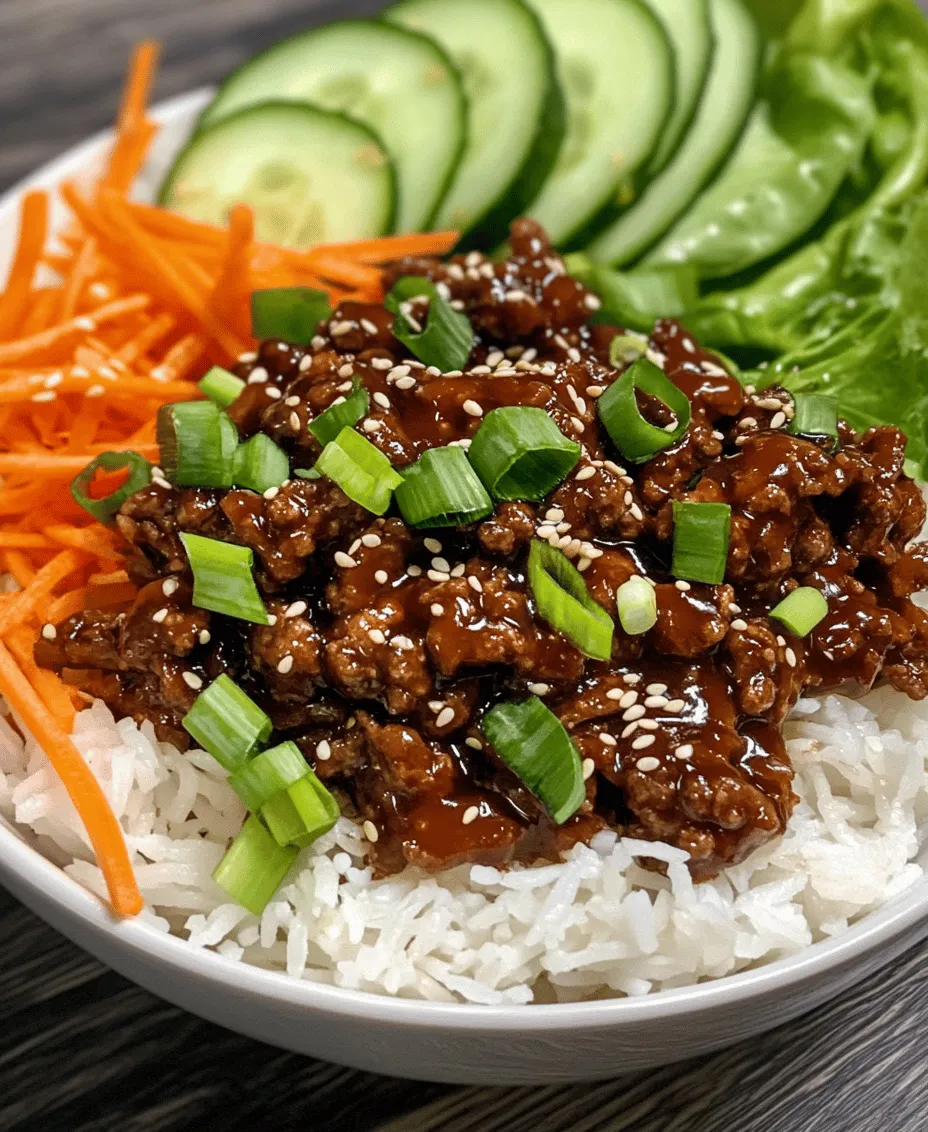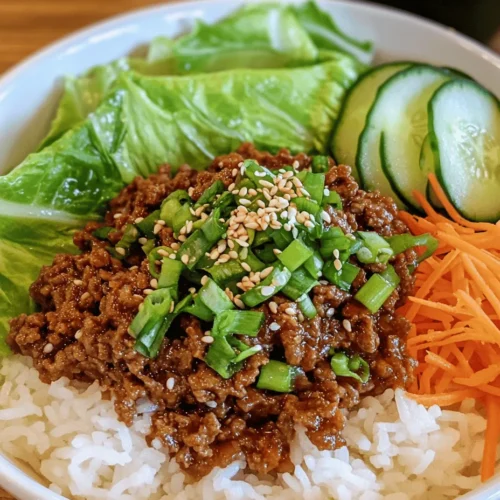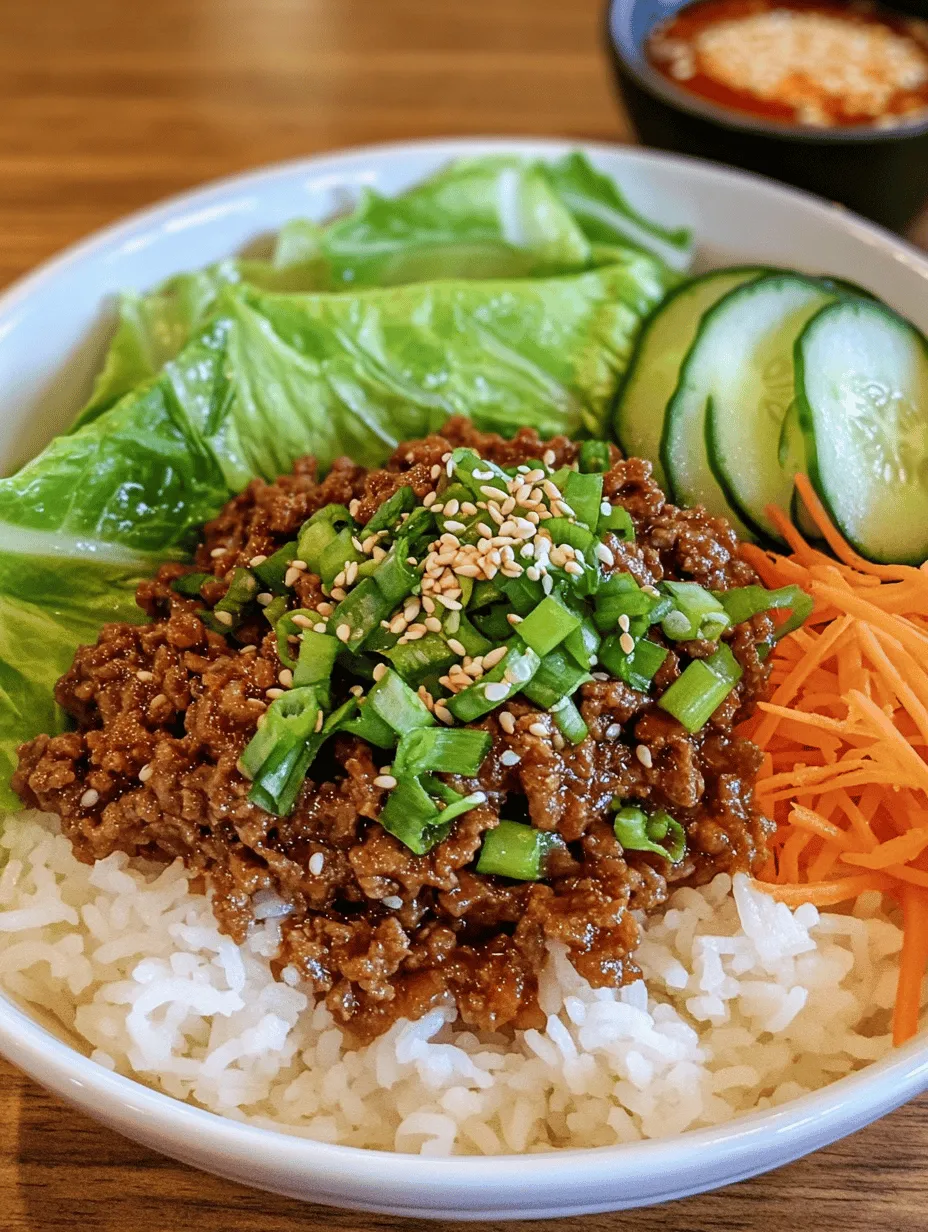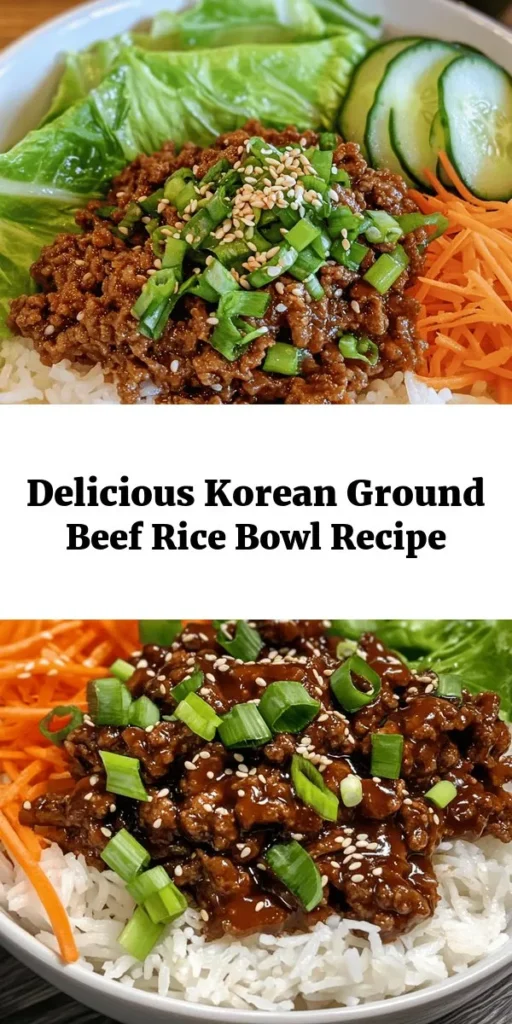Korean cuisine is celebrated for its bold flavors, vibrant colors, and comforting dishes that appeal to a wide array of palates. One standout recipe that encapsulates these qualities is the Korean Ground Beef Bowl. This dish, also known as “Bulgogi Bap,” is not only quick and easy to prepare but also packed with an array of textures and tastes that make for a satisfying meal. In this article, we will explore the origins of this delightful dish, the key ingredients that contribute to its unique flavor profile, and a step-by-step guide to making your own Korean Ground Beef Bowl at home.
The Allure of Korean Cuisine
Understanding Korean Food Culture
Korean food is deeply rooted in tradition, with flavors that reflect the country’s rich history and geography. The significance of flavors and ingredients in Korean cooking cannot be overstated. Fermentation, for example, plays a crucial role, with staples like kimchi and gochujang (Korean red chili paste) adding depth and complexity to dishes. The balance of salty, sweet, sour, and umami flavors is a hallmark of Korean cuisine, creating a harmonious dining experience.
Rice and meat are fundamental components of traditional Korean meals. Rice serves as the staple carbohydrate, providing a base for many dishes, while meat adds protein and richness. The combination of marinated beef with aromatic vegetables served over rice creates a meal that is both filling and flavorful. The Korean Ground Beef Bowl exemplifies this approach, offering a quick and accessible way to enjoy the essence of Korean flavors at home.
Popular Korean Dishes You Should Try
In addition to the Korean Ground Beef Bowl, the Korean culinary landscape features a variety of dishes worth exploring. From the iconic bibimbap, a colorful rice dish topped with assorted vegetables and a fried egg, to the savory jjigae (stews) like kimchi jjigae, the options are endless. Each dish tells a story and showcases the unique ingredients and cooking techniques of Korea.
The Korean Ground Beef Bowl fits seamlessly into this diverse array of offerings. It captures the essence of bulgogi—marinated grilled beef—while being approachable for home cooks. This dish is perfect for busy weeknights or casual gatherings, allowing you to experience the vibrant tastes of Korean cuisine without the need for extensive preparation.
Key Ingredients for Korean Ground Beef Bowl
Ground Beef: Choosing the Right Cut
When it comes to making the perfect Korean Ground Beef Bowl, the choice of meat is paramount. Ideally, you should use ground beef with a fat content of around 80/20. This ratio strikes a balance between flavor and juiciness, ensuring that the beef remains tender and flavorful during cooking. The fat helps to enhance the overall taste of the dish, allowing the seasonings to meld beautifully with the meat.
For those seeking alternatives, lean ground turkey or chicken can be substituted for a lighter option, while plant-based ground meat is an excellent choice for vegetarians or those following a vegan diet. Regardless of the protein you choose, the key is to ensure it is well-seasoned to capture the essence of Korean flavors.
Essential Seasonings and Condiments
The magic of the Korean Ground Beef Bowl lies in its seasonings. Here are some critical ingredients that elevate the dish:
– Soy Sauce: Soy sauce is a fundamental component in Korean cooking. There are various types, including light and dark soy sauce, each bringing its unique flavor profile. Light soy sauce is saltier and enhances the dish’s savory notes, while dark soy sauce adds depth and color. Opt for a high-quality, naturally brewed soy sauce for the best results.
– Gochujang: This Korean red chili paste is a staple in many Korean dishes. It offers a unique combination of heat and sweetness, which is essential for achieving the characteristic flavor of the Korean Ground Beef Bowl. Gochujang varies in heat level, so you can adjust the amount based on your spice preference. For a milder flavor, start with a small quantity and increase as desired.
– Brown Sugar and Sesame Oil: The balance of sweetness and umami is crucial in this recipe. Brown sugar adds a touch of sweetness that counterbalances the saltiness of the soy sauce and the heat of the gochujang. Sesame oil, with its nutty aroma, enhances the dish with a rich flavor and adds complexity.
Fresh Vegetables: Enhancing Health and Flavor
No Korean Ground Beef Bowl is complete without the vibrant addition of fresh vegetables. Green onions, carrots, and cucumbers are common choices that not only enhance the flavor but also contribute essential nutrients to the meal.
– Green Onions: These aromatic vegetables add a fresh crunch and mild onion flavor that complements the savory beef beautifully. They can be used as a garnish or cooked along with the beef for a more integrated flavor.
– Carrots: The natural sweetness of carrots pairs well with the savory elements of the dish. They provide a pleasant crunch and a pop of color, making the bowl visually appealing.
– Cucumbers: Sliced cucumbers add a refreshing element to the dish, balancing the rich flavors of the beef. They can be served raw on the side or lightly pickled for an extra zing.
Including fresh vegetables not only enhances the overall flavor of the Korean Ground Beef Bowl but also boosts its nutritional profile, making it a well-rounded meal.
Step-by-Step Guide to Making Korean Ground Beef Bowl
Preparation: Gathering Your Ingredients
Before diving into the cooking process, it’s essential to gather all your ingredients and prepare them for cooking. Here’s what you’ll need to make a delicious Korean Ground Beef Bowl:
Ingredients:
– For the Beef:
– 1 pound of ground beef (80/20 fat content)
– 3 tablespoons of soy sauce
– 1 tablespoon of gochujang (adjust based on spice preference)
– 1 tablespoon of brown sugar
– 1 tablespoon of sesame oil
– 2 cloves of garlic, minced
– 1 teaspoon of freshly grated ginger (optional)
– For the Vegetables:
– 2 green onions, chopped
– 1 medium carrot, julienned or grated
– 1 cup of cucumber, thinly sliced
– For Serving:
– 2 cups of cooked rice (white or brown)
– Additional sesame oil for drizzling (optional)
– Sesame seeds for garnish (optional)
Cooking Steps:
1. Prepare the Marinade: In a mixing bowl, combine the soy sauce, gochujang, brown sugar, sesame oil, minced garlic, and grated ginger. Whisk until well blended.
2. Marinate the Beef: Add the ground beef to the marinade and mix thoroughly, ensuring the beef is well coated. Allow it to marinate for at least 15-30 minutes. This step is crucial as it infuses the meat with the rich flavors of the marinade, enhancing the overall taste of the dish.
3. Cook the Beef: Heat a large skillet or frying pan over medium-high heat. Add the marinated ground beef to the hot skillet, breaking it apart with a spatula. Cook for about 5-7 minutes, or until the beef is browned and cooked through. Stir occasionally to ensure even cooking.
4. Add Vegetables: Once the beef is nearly cooked, add the chopped green onions and julienned carrots to the skillet. Stir everything together and cook for an additional 2-3 minutes until the vegetables are tender but still crisp.
5. Prepare the Rice: While the beef is cooking, prepare your rice according to package instructions. You can use a rice cooker for convenience or cook it on the stovetop.
6. Assemble the Bowl: To serve, spoon a generous portion of cooked rice into each bowl. Top with the flavorful ground beef mixture and garnish with sliced cucumbers. Drizzle with additional sesame oil if desired and sprinkle sesame seeds for a finishing touch.
By following these steps, you’ll create a delicious and satisfying Korean Ground Beef Bowl that beautifully showcases the bold flavors of Korean cuisine. The combination of savory beef, fresh vegetables, and fluffy rice makes this dish a perfect weeknight meal that you can whip up in no time. Enjoy the delightful tastes of Korea right in your own kitchen!

Importance of Mise en Place in Cooking
Before diving into creating your Korean Ground Beef Bowl, it’s crucial to understand the importance of mise en place, a French term meaning “everything in its place.” This practice is fundamental in cooking, especially when preparing dishes that require multiple components, such as this one. By organizing your ingredients and tools beforehand, you set the stage for a smoother cooking experience, ensuring that you can focus on the flavors and techniques rather than scrambling to find what you need.
To effectively mise en place for your Korean Ground Beef Bowl, start by gathering all ingredients and tools required for the dish. This includes your ground beef, vegetables, sauces, and any garnishes. Chop your vegetables into uniform pieces for even cooking and measure out your sauces and seasonings. By taking these steps, you minimize cooking time and reduce the chances of mistakes or forgotten ingredients, making the process enjoyable and efficient.
Tips for Efficiently Prepping Vegetables and Meat
Efficiently prepping your vegetables and meat can save time and enhance your cooking experience. Here are some practical tips to consider:
1. Use a Sharp Knife: A sharp knife is essential for quick and clean cuts. It reduces the risk of injury and allows you to cut through meat and vegetables with ease.
2. Batch Chop: If you’re making multiple servings or planning for future meals, chop your vegetables in larger batches. Store them in airtight containers in the fridge for up to three days.
3. Utilize a Food Processor: For vegetables like carrots, bell peppers, and onions, consider using a food processor. It significantly speeds up the chopping process and ensures uniformity.
4. Marinating Ground Beef: If time permits, marinating your ground beef for at least 30 minutes can infuse more flavor into the meat. A simple mixture of soy sauce, sesame oil, and garlic can do wonders.
Cooking the Ground Beef
Detailed Instructions for Achieving the Perfect Texture
To achieve a perfectly textured ground beef for your Korean bowl, follow these steps:
1. Heat the Pan: Begin by heating a large skillet or wok over medium-high heat. Adding a tablespoon of oil (such as vegetable or sesame) will help prevent sticking and enhance flavor.
2. Add the Beef: Once the pan is hot, add the ground beef. Use a spatula to break it up into small pieces as it cooks. This helps to ensure even cooking and browning.
3. Cook Until Browned: Continue cooking the beef for about 5-7 minutes, stirring occasionally. Look for a nice browned color, which indicates that the meat is cooked through and has developed a rich flavor.
4. Avoid Overcrowding: If you’re preparing a large batch, consider cooking the beef in two separate batches. Overcrowding the pan can lead to steaming rather than browning, affecting the texture.
Tips for Draining Excess Grease Without Losing Flavor
Once your ground beef is cooked to perfection, you may notice some grease accumulating in the pan. Here’s how to drain excess grease while retaining flavor:
1. Tilt the Pan: Carefully tilt the skillet to one side, allowing the grease to pool. Use a spoon to scoop out the grease without removing the flavorful bits stuck to the bottom.
2. Use a Slotted Spoon: Alternatively, you can transfer the cooked beef to a plate using a slotted spoon. This allows the grease to drain back into the pan while keeping the meat intact.
3. Reserve Some Fat: Consider leaving a little bit of the grease—about a teaspoon—back in the pan to help sauté your vegetables. This adds flavor and moisture to your dish.
Creating the Flavorful Sauce
Step-by-Step Guide to Mixing the Seasoning
The sauce is the heart of your Korean Ground Beef Bowl. Follow these steps to create a delicious and balanced flavor profile:
1. Gather Your Ingredients: You will need soy sauce, brown sugar, garlic, ginger, sesame oil, and a pinch of red pepper flakes for heat.
2. Mix the Ingredients: In a small bowl, combine ¼ cup of soy sauce, 2 tablespoons of brown sugar, 2 minced garlic cloves, 1 teaspoon of freshly grated ginger, and 1 tablespoon of sesame oil. If you enjoy heat, add ½ teaspoon of red pepper flakes.
3. Whisk Together: Use a whisk or fork to combine all the ingredients thoroughly until the sugar dissolves completely. Taste the mixture and adjust as necessary—adding more sugar for sweetness or soy sauce for saltiness.
How to Adjust Flavors to Suit Personal Preferences
The beauty of this sauce lies in its versatility. If you prefer a sweeter flavor, increase the brown sugar. For a saltier kick, add more soy sauce. If you enjoy spice, incorporate additional red pepper flakes or a dash of Sriracha. Don’t hesitate to experiment—this is your dish!
Combining Ingredients for the Perfect Bowl
Techniques for Integrating Vegetables into the Beef Mixture
Once your ground beef is cooked and your sauce is ready, it’s time to bring everything together:
1. Add Vegetables: Transfer your prepped vegetables—such as bell peppers, carrots, and green onions—into the pan with the beef.
2. Stir-Fry: Stir the mixture frequently, allowing the vegetables to soften slightly while still retaining their crunch. This usually takes about 3-4 minutes.
3. Pour the Sauce: Drizzle the prepared sauce over the beef and vegetable mixture. Stir well to ensure every piece is coated in the flavorful sauce.
Importance of Timing for Cooking Vegetables to Maintain Texture
Timing is key in ensuring your vegetables remain crisp yet tender. Add heartier vegetables like bell peppers and carrots first, sautéing them for a minute or two before adding more delicate ones like green onions or snap peas. This technique ensures that every component of your bowl has the perfect texture.
Assembling the Bowl: Presentation Matters
Layering Ingredients for an Appealing Presentation
Assembling your Korean Ground Beef Bowl is an art. Start with a base of your chosen grain, such as rice or quinoa. Next, add a generous helping of the beef and vegetable mixture on top.
1. Create a Colorful Contrast: For visual appeal, layer ingredients to create contrast. For example, add bright greens like cucumber or lettuce after the beef, and finish with a sprinkle of sesame seeds or chopped green onions on top.
2. Use a Deep Bowl: Using a deep bowl allows for a more dramatic presentation and makes it easier to mix the ingredients as you eat.
Creative Serving Ideas: From Traditional to Modern Twists
While the traditional Korean Ground Beef Bowl is delightful, don’t shy away from creative twists. Consider:
– Garnishing with Kimchi: Adding a side of kimchi enhances the flavors and adds a spicy kick.
– Serving with Fried Egg: Topping your bowl with a fried egg adds richness and visual appeal.
– Using Lettuce Wraps: For a low-carb option, serve the beef mixture in lettuce leaves instead of rice.
Nutritional Information and Serving Suggestions
Understanding the Nutritional Profile
The Korean Ground Beef Bowl is not only delicious but also packed with nutrients. Here’s a breakdown of what you can expect from one serving:
– Calories: Approximately 450-500 calories, depending on the serving size and choice of grains.
– Protein: Rich in protein thanks to the ground beef, providing about 25-30 grams per serving.
– Fat: Contains about 20 grams of fat, which varies based on the meat used (lean beef vs. regular).
– Carbohydrates: About 40 grams, primarily from the rice or quinoa.
Including a variety of food groups in your meal—protein, grains, and vegetables—ensures a balanced diet, promoting health and well-being.
Serving Suggestions and Variations
To keep your meals exciting, consider these alternative grain options and adaptations:
– Quinoa: A nutrient-dense alternative, quinoa packs a protein punch and adds a unique texture.
– Brown Rice: For added fiber, brown rice is a wonderful substitute that provides a nutty flavor.
– Cauliflower Rice: For a low-carb option, cauliflower rice is light and complements the beef mixture beautifully.
For those seeking vegetarian options, consider using tofu or tempeh in place of beef. Simply marinate and sauté them in the same way as the beef, adjusting the sauce to enhance their flavors.
Conclusion: Enjoying Your Korean Ground Beef Bowl
The Korean Ground Beef Bowl is not just a meal; it’s an experience that brings the vibrant flavors of Korea right into your home. By following the steps outlined in this article, you can create a satisfying and delicious dish that reflects the essence of Korean cuisine. Whether enjoyed as a quick weeknight dinner or as a meal for entertaining guests, this bowl is sure to impress with its rich flavors and fresh ingredients. Dive into this culinary adventure and savor the delightful taste of Korea with every bite.



